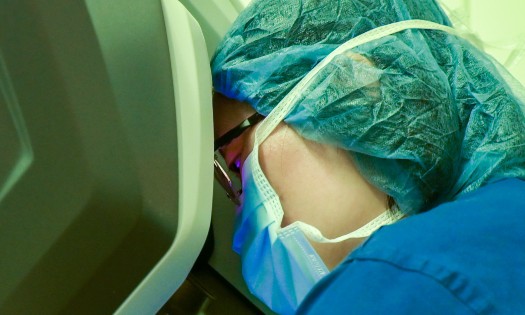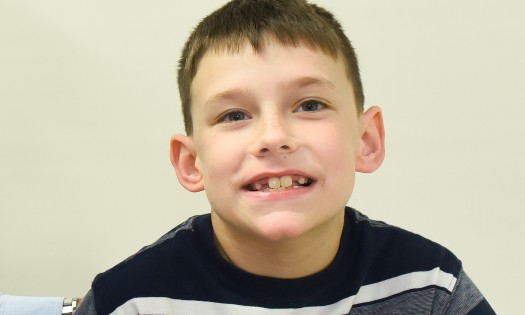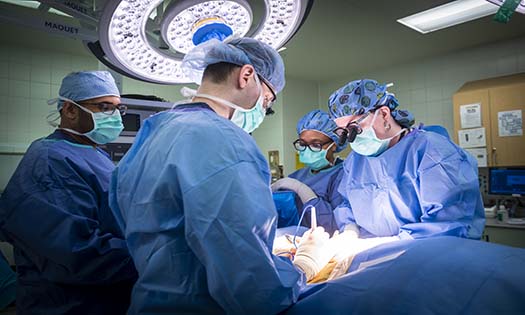An adolescent boy was recently referred to the urology team at Children’s Health℠, Children’s Medical Center Dallas with intermittent abdominal pain that had lasted for several months. No one had been able to pinpoint its cause, despite extensive testing. Then we performed an abdominal ultrasound that delivered an important clue: He lacked a kidney on his right side.
Led by Craig Peters, M.D., the UT Southwestern physicians at Children’s Health suspected there were related abnormalities that could explain the patient’s pain. A follow-up MRI revealed the source: a seminal vesicle cyst, which Dr. Peters removed via robotic surgery. The diagnostic process we followed could be informative to physicians faced with patients who have abdominal pain that doesn’t follow a consistent pattern and defies routine diagnostic testing.
“A kidney that’s either absent or not well developed often goes hand-in-glove with cystic structures behind the bladder, but physicians might not think to look for them because they’re relatively rare,” says Dr. Peters, Division Director of Pediatric Urology at Children’s Health and Professor at UT Southwestern. “That’s what made this case interesting — we had to put a few puzzle pieces together to know what to look for.”
Identifying Zinner Syndrome and Related Abnormalities
Understandably, many physicians might not think to connect abdominal pain with potential urological causes because there are so many other, more likely causes. But it can be wise to consult with a urologist when:
A patient has repeated episodes of severe pain with nausea and vomiting that have no other identifiable cause
Abdominal pain is associated with any urinary symptoms, including hematuria (blood in the urine), urinary infection or kidney stones
Often, a simple ultrasound of the kidneys and bladder is sufficient to identify significant issues — or rule them out. For the patient with the seminal vesicle cyst, the diagnostic puzzle began with the observation that one of the patient’s kidneys had never developed.
“Unilateral renal agenesis is a sign of a rare congenital condition called Zinner syndrome,” Dr. Peters says. “Very often when a kidney doesn't develop, other structures in the pelvis — the prostate, the seminal vesicles — don't develop properly either, and the problem almost always manifests at puberty.”
This knowledge is what prompted him to investigate further down the bladder.
“If a patient has pelvic symptoms and you see a small or absent kidney, you should always look closely at the pelvis,” Dr. Peters says.
As with all patients, Dr. Peters and his urology colleagues applied a diagnostic approach that aims to minimize patient discomfort. Many urological imaging tests require putting a catheter in the urethra, which can be especially disconcerting and uncomfortable for children. The Children’s Health team avoids these tests when less invasive tests could deliver equally helpful results.
“We’ve dedicated a lot of time to streamlining our imaging and we’ve learned that an MRI is ideal for getting a good image of the pelvis,” Dr. Peters says. “Then if we need to do a cystography to understand the anatomy in preparation for surgery, we wait until the patient is under anesthesia.”
This patient’s MRI confirmed our suspicion of further abnormalities, by identifying a revealed a seminal vesicle cyst.
After weighing appropriate treatment strategies, we decided on surgical removal.
“The cyst was very inflamed, it wasn’t likely to go away and it could have potentially become the source of a serious infection,” Dr. Peters says. “That, combined with the fact that the patient was in pain, made us decide that removal was the best course of action.”
Using Robotic Surgery to Improve Urology Outcomes
Surgery on structures behind the bladder can be tricky because access is so difficult, and because the space behind the bladder is small and adjacent to the pelvic nerves and reproductive organs. Historically, surgeons would make an abdominal incision and split the bladder to access this area. As an alternative, Dr. Peters and his colleagues pioneered using robotic techniques to perform surgery in this area.
“To me, using robotic surgery in these circumstances is a no-brainer: It’s more precise, it reduces the risk of damaging other things and the recovery is much faster,” he says.
During this patient’s procedure, Dr. Peters discovered that the cyst was especially inflamed and was adhered to part of the bladder. He methodically looked for a separation between the cyst and the bladder, and ultimately decided to cut into part of the bladder to be sure to entirely remove the cyst.
“You want to be sure to not leave any part of the cyst wall because they can recur,” he says.
Dr. Peters repaired the bladder during the same procedure. The patient went home two days later, and quickly got back to normal activities — including playing football.
Top Pediatric Urology Outcomes
Like all Children’s Health patients, this patient benefited from a team approach that united several experts to evaluate his case and decide on treatment.
“I brought the case to our regular conference that includes five pediatric urologists with about 100 years of combined experience,” Dr. Peters says. “Everyone knew what this condition was even though it’s so rare.”
All five of those experts are certified in the Da Vinci Surgical System. This helps Children’s Health patients maintain a close connection with their physicians, because the urologist they see is also the one who performs their surgery.
This combination of expertise and teamwork helps explain why the Children’s Health urology outcomes are on par with other top national centers.
“The academic environment here is second to none, and that shared learning and shared evaluation means that we can make the most accurate diagnosis and decide on the treatment strategy that gives each and every patient the best opportunity for excellent outcomes,” Dr. Peters says.
Learn more about the urology department at Children’s Health.


